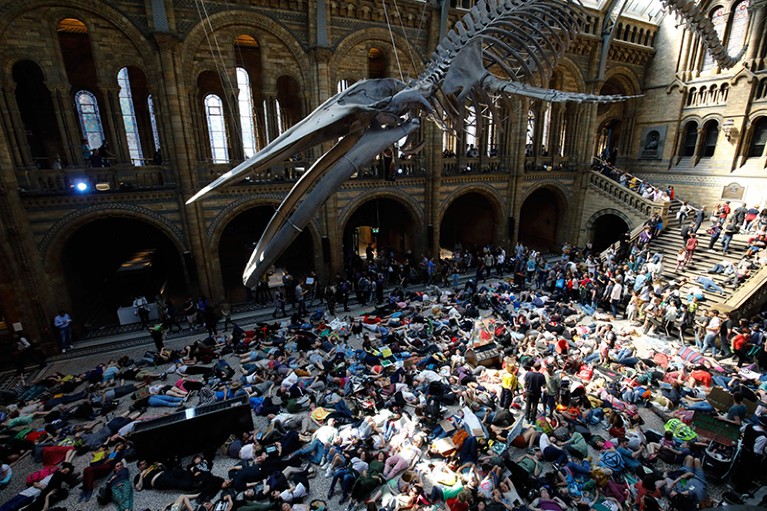RESEARCH
Giant carnivore identified after decades Lions have long held the unofficial title ‘king of the beasts’, but a newfound carnivore from ancient Africa might have proved a worthy challenger for the throne. The enormous predator, named Simbakubwa kutokaafrika — “big lion from Africa” in Swahili — was described last week (M. R. Borths and N. J. Stevens J. Vert. Paleontol. 39, e1570222; 2019). It roamed what is now Kenya around 22 million years ago, had three rows of meat-slicing teeth and was probably larger than a polar bear. Despite its name, Simbakubwa wasn’t a cat: it was one of a group of animals called hyaenodonts that includes some of the biggest predatory mammals ever to walk on Earth. A Simbakubwa fossil was unearthed sometime between 1978 and 1981. But its true identity escaped researchers until 2013, when a US palaeontologist was poking through the fossil-mammal collection at the Nairobi National Museum during a trip to Kenya.

The newly identified species Simbakubwa kutokaafrika had three rows of meat-shearing teeth and was larger than a polar bear.Credit: Mauricio Anton
No more isolation An experimental gene therapy has restored functioning immune systems to eight young children with a severe disorder that left them open to all manner of infections and sentenced them to a life of isolation. The children have mutations in a gene that is crucial for immune-system development, causing a disorder called X-linked severe combined immunodeficiency (SCID-X1). For them, even a common cold can be fatal. The gene therapy provides a functional copy of the mutated gene, called IL2RG. The children now have immune systems that could protect them against common ailments, researchers reported on 17 April (E. Mamcarz et al. N. Engl. J. Med. 380, 1525–1534; 2019). The scientists used a virus — a disabled relative of HIV — to insert IL2RG into the cells of affected children. The team also gave the group a low dose of chemotherapy before the treatment; that approach is already used in another gene therapy, approved by the European Medicines Agency in 2016, for a related disease called ADA-SCID.
POLICY
Gene-editing update The Australian government will not regulate the use of gene-editing technologies in plants, animals and human cell lines if they do not introduce new genetic material. The decision follows a review of the country’s gene-technology regulations. Previously, the use of such technologies, including CRISPR–Cas9, was restricted in practice because the techniques were governed by the same rules as conventional genetic modifications, which require government approval. The amended rules remove that requirement for tools in which proteins cut DNA at a specific target site — as long as the tools allow the host cell to repair the break naturally, rather than using a template containing genetic material to direct the repair. Gene-editing technologies that use a template, or that insert other genetic material into the cell, will continue to be regulated. The updated rules take effect on 8 October, and do not apply to the use of gene editing in human embryos for reproduction, which is banned.
EVENTS
Scientists cleared Stanford University in California has cleared three of its faculty members of any wrongdoing related to their interactions with He Jiankui, the biophysicist who created the first gene-edited babies using CRISPR–Cas9 technology. The researchers, whom Stanford did not name, “had no research, financial or organizational ties” to the gene-edited-baby scandal, the university said in a statement on 16 April. Its investigation found that the researchers tried to discourage He from following through with his controversial experiments, which he undertook while working at the Southern University of Science and Technology in Shenzhen, China. “When Dr. He did not heed their recommendations and proceeded, Stanford researchers urged him to follow proper scientific practices,” the statement said. He’s relationships with the unnamed researchers date back to 2011, when he did postdoctoral research at Stanford.
Climate protests More than 70 academics have pledged their support for a series of climate protests in London that have disrupted the city for more than a week and led to at least 1,000 arrests. Environmental activists from the protest group, called Extinction Rebellion, say that humanity is facing an “unprecedented global emergency” because of climate change, and that they are declaring a rebellion against the government for “criminal inaction” on the emergency. Thousands of people have turned out in the protests, which started on 15 April and are continuing. The demonstrations have brought parts of central London, including Oxford Circus and Parliament Square, to a standstill, and on 22 April, protesters staged a die-in at the Natural History Museum (pictured). Coordinated protests have also taken place worldwide.

Climate-change activists staged a mass ‘die in’ under at the Natural History Museum in London on 22 April.Credit: Tolga Akmen/AFP/Getty
FUNDING
Opioid fight The US National Institutes of Health (NIH) has awarded more than US$350 million to four research teams that will test ways of reducing accidental deaths from opioid use. Those strategies include distributing drugs that can reverse opioid overdoses — such as naloxone — and programmes connecting people who have been convicted of drug crimes with addiction treatment. The scientists will work with groups including government agencies and medical professionals in study communities across four states: Kentucky, Massachusetts, New York and Ohio. A fifth research team, at RTI International in Research Triangle Park, North Carolina, will coordinate the overall effort. The goal is to reduce opioid-overdose deaths by 40% in 3 years, and to create a blueprint that communities across the United States could use, NIH director Francis Collins said at a press conference on 18 April. The effort is part of an opioid-research strategy that the NIH introduced in 2018.
EU science cash The European Parliament has approved the content and participation rules of Horizon Europe, the European Union’s next major research-funding programme for 2021–27. The framework will follow the current Horizon 2020 programme. In a vote on 17 April, members of the European Parliament (MEPs) backed the programme’s new elements, including the European Innovation Council, which will fund top-level applied research and ‘missions’, aimed at supporting research into major topics such as climate change and cancer. In a debate the previous day, Christian Ehler, one of the two MEPs overseeing Horizon Europe, said the programme was focused on the needs and interests of “ordinary European people”. Under the proposal, at least 35% of funding would go to climate change and 3.3% would be targeted at Europe’s least research-intensive regions. Horizon Europe’s budget, pitched at €100 billion (US$113 billion), has yet to be agreed by member states in the European Council. The parliament is pushing for €120 billion, but member states are likely to prefer a lower budget.
UNIVERSITIES
Harassment survey A survey of women pursuing US undergraduate degrees in physics has found that roughly 74% report having experienced at least one type of sexual harassment during their science studies. The research, conducted in 2017 at a series of US conferences for undergraduate students, was published on 22 April (L. M. Aycock et al. Phys. Rev. Phys. Educ. Res. 15, 010121; 2019). The authors recruited students who identified as female, and asked them to answer a questionnaire about sexual experiences, adapted from a version used for previous studies, including to assess harassment in the US military. Of the 455 people who responded, 338 reported having experienced some form of sexual harassment, including gender harassment — such as being ignored because of their sex or gender — unwanted sexual attention or a combination during the previous two years. The incidents took place in research laboratories, classrooms or university departments, or at work-related events.
TREND WATCH
Scientists have uncovered the first strong evidence that the amount of plastic polluting the oceans has risen vastly in recent decades — by analysing 60 years of log books for plankton-tracking instruments known as continuous plankton recorders (CPRs). Ships have towed CPRs millions of kilometres across the Atlantic Ocean, but in recent years, the devices have often returned tangled up in plastic. To determine whether these entanglements have become more common, researchers looked through CPR logs from the North Atlantic between 1957 and 2016. Over the 60-year period, 208 entanglements with large plastic items were recorded, including a few in the 1950s and 1960s. The number of encounters rose through the 1980s and 1990s, peaking in the 2000s, when the CPRs were becoming entangled in roughly 3% of tows. Fishing gear was the biggest culprit — involved in 55% of all entanglements. There was no significant change in the number of encounters with natural items, such as seaweed, over the same period. Long-term data on ocean plastics have been scant, researchers say; previous studies looked mainly at the ingestion of plastic by sea creatures over shorter timescales.






